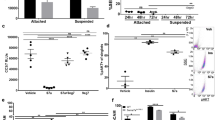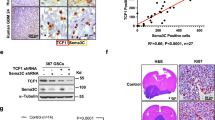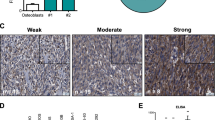Abstract
Semaphorin 3B (SEMA3B) is a secreted axonal guidance molecule that is expressed during development and throughout adulthood. Recently, SEMA3B has emerged as a tumor suppressor in non-neuronal cells. Here, we show that SEMA3B is a direct target of GATA3 transcriptional activity. GATA3 is a key transcription factor that regulates genes involved in mammary luminal cell differentiation and tumor suppression. We show that GATA3 relies on SEMA3B for suppression of tumor growth. Loss of SEMA3B renders GATA3 inactive and promotes aggressive breast cancer development. Overexpression of SEMA3B in cells lacking GATA3 induces a GATA3-like phenotype and higher levels of SEMA3B are associated with better cancer patient prognosis. Moreover, SEMA3B interferes with activation of LIM kinases (LIMK1 and LIMK2) to abrogate breast cancer progression. Our data provide new insights into the role of SEMA3B in mammary gland and provides a new branch of GATA3 signaling that is pivotal for inhibition of breast cancer progression and metastasis.
This is a preview of subscription content, access via your institution
Access options
Subscribe to this journal
Receive 50 print issues and online access
$259.00 per year
only $5.18 per issue
Buy this article
- Purchase on Springer Link
- Instant access to full article PDF
Prices may be subject to local taxes which are calculated during checkout




Similar content being viewed by others
References
Luo Y, Raible D, Raper JA . Collapsin: a protein in brain that induces the collapse and paralysis of neuronal growth cones. Cell 1993; 75: 217–227.
Neufeld G, Kessler O . The semaphorins: versatile regulators of tumour progression and tumour angiogenesis. Nat Rev Cancer 2008; 8: 632–645.
Staton CA, Shaw LA, Valluru M, Hoh L, Koay I, Cross SS et al. Expression of class 3 semaphorins and their receptors in human breast neoplasia. Histopathology 2011; 59: 274–282.
Kruger RP, Aurandt J, Guan KL . Semaphorins command cells to move. Nat Rev Mol Cell Biol 2005; 6: 789–800.
Driessens MH, Hu H, Nobes CD, Self A, Jordens I, Goodman CS et al. Plexin-B semaphorin receptors interact directly with active Rac and regulate the actin cytoskeleton by activating Rho. Curr Biol 2001; 11: 339–344.
Turner LJ, Nicholls S, Hall A . The activity of the plexin-A1 receptor is regulated by Rac. J Biol Chem 2004; 279: 33199–33205.
Falk J, Bechara A, Fiore R, Nawabi H, Zhou H, Hoyo-Becerra C et al. Dual functional activity of semaphorin 3B is required for positioning the anterior commissure. Neuron 2005; 48: 63–75.
Jin Z, Strittmatter SM . Rac1 mediates collapsin-1-induced growth cone collapse. J Neurosci 1997; 17: 6256–6263.
Hall C, Brown M, Jacobs T, Ferrari G, Cann N, Teo M et al. Collapsin response mediator protein switches RhoA and Rac1 morphology in N1E-115 neuroblastoma cells and is regulated by Rho kinase. J Biol Chem 2001; 276: 43482–43486.
Kuroki T, Trapasso F, Yendamuri S, Matsuyama A, Alder H, Williams NN et al. Allelic loss on chromosome 3p21.3 and promoter hypermethylation of semaphorin 3B in non-small cell lung cancer. Cancer Res 2003; 63: 3352–3355.
Castro-Rivera E, Ran S, Thorpe P, Minna JD . Semaphorin 3B (SEMA3B) induces apoptosis in lung and breast cancer, whereas VEGF165 antagonizes this effect. Proc Natl Acad Sci USA 2004; 101: 11432–11437.
Sekido Y, Bader S, Latif F, Chen JY, Duh FM, Wei MH et al. Human semaphorins A(V) and IV reside in the 3p21.3 small cell lung cancer deletion region and demonstrate distinct expression patterns. Proc Natl Acad Sci USA 1996; 93: 4120–4125.
Tse C, Xiang RH, Bracht T, Naylor SL . Human semaphorin 3B (SEMA3B) located at chromosome 3p21.3 suppresses tumor formation in an adenocarcinoma cell line. Cancer Res 2002; 62: 542–546.
Tomizawa Y, Sekido Y, Kondo M, Gao B, Yokota J, Roche J et al. Inhibition of lung cancer cell growth and induction of apoptosis after reexpression of 3p21.3 candidate tumor suppressor gene SEMA3B. Proc Natl Acad Sci USA 2001; 98: 13954–13959.
Kouros-Mehr H, Slorach EM, Sternlicht MD, Werb Z . GATA-3 maintains the differentiation of the luminal cell fate in the mammary gland. Cell 2006; 127: 1041–1055.
Asselin-Labat ML, Sutherland KD, Barker H, Thomas R, Shackleton M, Forrest NC et al. Gata-3 is an essential regulator of mammary-gland morphogenesis and luminal-cell differentiation. Nat Cell Biol 2007; 9: 201–209.
Dydensborg AB, Rose AA, Wilson BJ, Grote D, Paquet M, Giguere V et al. GATA3 inhibits breast cancer growth and pulmonary breast cancer metastasis. Oncogene 2009; 28: 2634–2642.
Kouros-Mehr H, Kim JW, Bechis SK, Werb Z . GATA-3 and the regulation of the mammary luminal cell fate. Curr Opin Cell Biol 2008; 20: 164–170.
Kaufman CK, Zhou P, Pasolli HA, Rendl M, Bolotin D, Lim KC et al. GATA-3: an unexpected regulator of cell lineage determination in skin. Genes Dev 2003; 17: 2108–2122.
Yagi R, Zhu J, Paul WE . An updated view on transcription factor GATA3-mediated regulation of Th1 and Th2 cell differentiation. Int Immunol 2011; 23: 415–420.
Sellheyer K, Krahl D . Expression pattern of GATA-3 in embryonic and fetal human skin suggests a role in epidermal and follicular morphogenesis. J Cutan Pathol 2010; 37: 357–361.
Home P, Ray S, Dutta D, Bronshteyn I, Larson M, Paul S . GATA3 is selectively expressed in the trophectoderm of peri-implantation embryo and directly regulates Cdx2 gene expression. J Biol Chem 2009; 284: 28729–28737.
Du F, Yuan P, Wang T, Zhao J, Zhao Z, Luo Y et al. The significance and therapeutic potential of GATA3 expression and mutation in breast cancer: a systematic review. Med Res Rev 2015; 35: 1300–1315.
Ko LJ, Engel JD . DNA-binding specificities of the GATA transcription factor family. Mol Cell Biol 1993; 13: 4011–4022.
Kouros-Mehr H, Bechis SK, Slorach EM, Littlepage LE, Egeblad M, Ewald AJ et al. GATA-3 links tumor differentiation and dissemination in a luminal breast cancer model. Cancer Cell 2008; 13: 141–152.
Wilson BJ, Giguere V . Meta-analysis of human cancer microarrays reveals GATA3 is integral to the estrogen receptor alpha pathway. Mol Cancer 2008; 7: 49.
Bertucci F, Houlgatte R, Benziane A, Granjeaud S, Adelaide J, Tagett R et al. Gene expression profiling of primary breast carcinomas using arrays of candidate genes. Hum Mol Genet 2000; 9: 2981–2991.
Hoch RV, Thompson DA, Baker RJ, Weigel RJ . GATA-3 is expressed in association with estrogen receptor in breast cancer. Int J Cancer 1999; 84: 122–128.
Mehra R, Varambally S, Ding L, Shen R, Sabel MS, Ghosh D et al. Identification of GATA3 as a breast cancer prognostic marker by global gene expression meta-analysis. Cancer Res 2005; 65: 11259–11264.
Jiang YZ, Yu KD, Zuo WJ, Peng WT, Shao ZM . GATA3 mutations define a unique subtype of luminal-like breast cancer with improved survival. Cancer 2014; 120: 1329–1337.
Van 't Veer LJ, Dai H, van de Vijver MJ, He YD, Hart AA, Mao M et al. Gene expression profiling predicts clinical outcome of breast cancer. Nature 2002; 415: 530–536.
Chou J, Lin JH, Brenot A, Kim JW, Provot S, Werb Z . GATA3 suppresses metastasis and modulates the tumour microenvironment by regulating microRNA-29b expression. Nat Cell Biol 2013; 15: 201–213.
Lagoutte E, Villeneuve C, Lafanechere L, Wells CM, Jones GE, Chavrier P et al. LIMK regulates tumor-cell invasion and matrix degradation through tyrosine phosphorylation of MT1-MMP. Sci Rep 2016; 6: 24925.
McConnell BV, Koto K, Gutierrez-Hartmann A . Nuclear and cytoplasmic LIMK1 enhances human breast cancer progression. Mol Cancer 2011; 10: 75.
Bagheri-Yarmand R, Mazumdar A, Sahin AA, Kumar R . LIM kinase 1 increases tumor metastasis of human breast cancer cells via regulation of the urokinase-type plasminogen activator system. Int J Cancer 2006; 118: 2703–2710.
Johnson EO, Chang KH, Ghosh S, Venkatesh C, Giger K, Low PS et al. LIMK2 is a crucial regulator and effector of Aurora-A-kinase-mediated malignancy. J Cell Sci 2012; 125 (Pt 5): 1204–1216.
Shea KF, Wells CM, Garner AP, Jones GE . ROCK1 and LIMK2 interact in spread but not blebbing cancer cells. PLoS One 2008; 3: e3398.
Edwards DC, Sanders LC, Bokoch GM, Gill GN . Activation of LIM-kinase by Pak1 couples Rac/Cdc42 GTPase signalling to actin cytoskeletal dynamics. Nat Cell Biol 1999; 1: 253–259.
Ohashi K, Nagata K, Maekawa M, Ishizaki T, Narumiya S, Mizuno K . Rho-associated kinase ROCK activates LIM-kinase 1 by phosphorylation at threonine 508 within the activation loop. J Biol Chem 2000; 275: 3577–3582.
Brose K, Bland KS, Wang KH, Arnott D, Henzel W, Goodman CS et al. Slit proteins bind Robo receptors and have an evolutionarily conserved role in repulsive axon guidance. Cell 1999; 96: 795–806.
Wang KH, Brose K, Arnott D, Kidd T, Goodman CS, Henzel W et al. Biochemical purification of a mammalian slit protein as a positive regulator of sensory axon elongation and branching. Cell 1999; 96: 771–784.
Macias H, Moran A, Samara Y, Moreno M, Compton JE, Harburg G et al. SLIT/ROBO1 signaling suppresses mammary branching morphogenesis by limiting basal cell number. Dev Cell 2011; 20: 827–840.
Ballard MS, Zhu A, Iwai N, Stensrud M, Mapps A, Postiglione MP et al. Mammary stem cell self-renewal is regulated by Slit2/Robo1 signaling through SNAI1 and mINSC. Cell Rep 2015; 13: 290–301.
Marlow R, Strickland P, Lee JS, Wu X, Pebenito M, Binnewies M et al. SLITs suppress tumor growth in vivo by silencing Sdf1/Cxcr4 within breast epithelium. Cancer Res 2008; 68: 7819–7827.
Soker S, Takashima S, Miao HQ, Neufeld G, Klagsbrun M . Neuropilin-1 is expressed by endothelial and tumor cells as an isoform-specific receptor for vascular endothelial growth factor. Cell 1998; 92: 735–745.
Bernatchez PN, Rollin S, Soker S, Sirois MG . Relative effects of VEGF-A and VEGF-C on endothelial cell proliferation, migration and PAF synthesis: role of neuropilin-1. J Cell Biochem 2002; 85: 629–639.
Castro-Rivera E, Ran S, Brekken RA, Minna JD . Semaphorin 3B inhibits the phosphatidylinositol 3-kinase/Akt pathway through neuropilin-1 in lung and breast cancer cells. Cancer Res 2008; 68: 8295–8303.
Rhodes DR, Yu J, Shanker K, Deshpande N, Varambally R, Ghosh D et al. ONCOMINE: a cancer microarray database and integrated data-mining platform. Neoplasia 2004; 6: 1–6.
Cancer Genome Atlas N.. Comprehensive molecular portraits of human breast tumours. Nature 2012; 490: 61–70.
Finak G, Bertos N, Pepin F, Sadekova S, Souleimanova M, Zhao H et al. Stromal gene expression predicts clinical outcome in breast cancer. Nat Med 2008; 14: 518–527.
Aguirre-Gamboa R, Gomez-Rueda H, Martinez-Ledesma E, Martinez-Torteya A, Chacolla-Huaringa R, Rodriguez-Barrientos A et al. SurvExpress: an online biomarker validation tool and database for cancer gene expression data using survival analysis. PLoS One 2013; 8: e74250.
Acknowledgements
We acknowledge Dr Gera Neufeld for providing the SEMA3B overexpression DNA construct. We thank Dr Luca Tamagnone for his generous gift of lentiviral SEMA3B short hairpin RNA constructs. We thank Elena Atamaniuc for technical assistance. This study was supported by funds from the National Cancer Institute (R01 CA129523 and R01 CA190851 to ZW); PS was supported by an Institutional National Research Service Award (T32 CA108462); C-YW was supported by a grant from the Ministry of Science and Technology, Taiwan (104-2917-I-006-002); CH was supported by funds from the Tegger Foundation, Wenner-Gren Foundations, Sweden-America Foundation, Swedish Society of Medicine and Swedish Society for Medical Research; and HGV was supported by a Becas Chile Scholarship.
Author contributions
PS, C-YW and ZW designed the project; PS, C-YW, CH, HGV, AR and YY performed the experiments; JC contributed material; PS, C-YW and ZW analyzed and interpreted the data; M-DL provided supervision; PS, C-YW and ZW wrote the paper.
Author information
Authors and Affiliations
Corresponding author
Ethics declarations
Competing interests
The authors declare no conflict of interest.
Additional information
Supplementary Information accompanies this paper on the Oncogene website
Supplementary information
Rights and permissions
About this article
Cite this article
Shahi, P., Wang, CY., Chou, J. et al. GATA3 targets semaphorin 3B in mammary epithelial cells to suppress breast cancer progression and metastasis. Oncogene 36, 5567–5575 (2017). https://doi.org/10.1038/onc.2017.165
Received:
Revised:
Accepted:
Published:
Issue Date:
DOI: https://doi.org/10.1038/onc.2017.165
This article is cited by
-
LIMK2 promotes melanoma tumor growth and metastasis through G3BP1-ESM1 pathway-mediated apoptosis inhibition
Oncogene (2023)
-
Evaluation of Circ_0000977-Mediated Regulatory Network in Breast Cancer: A Potential Discriminative Biomarker for Triple-Negative Tumors
Biochemical Genetics (2023)
-
Circular RNA hsa_circ_0044234 as distinct molecular signature of triple negative breast cancer: a potential regulator of GATA3
Cancer Cell International (2021)
-
A transcription factor that promotes proliferation, migration, invasion, and epithelial–mesenchymal transition of ovarian cancer cells and its possible mechanisms
BioMedical Engineering OnLine (2021)
-
Genomic profiling reveals heterogeneous populations of ductal carcinoma in situ of the breast
Communications Biology (2021)



